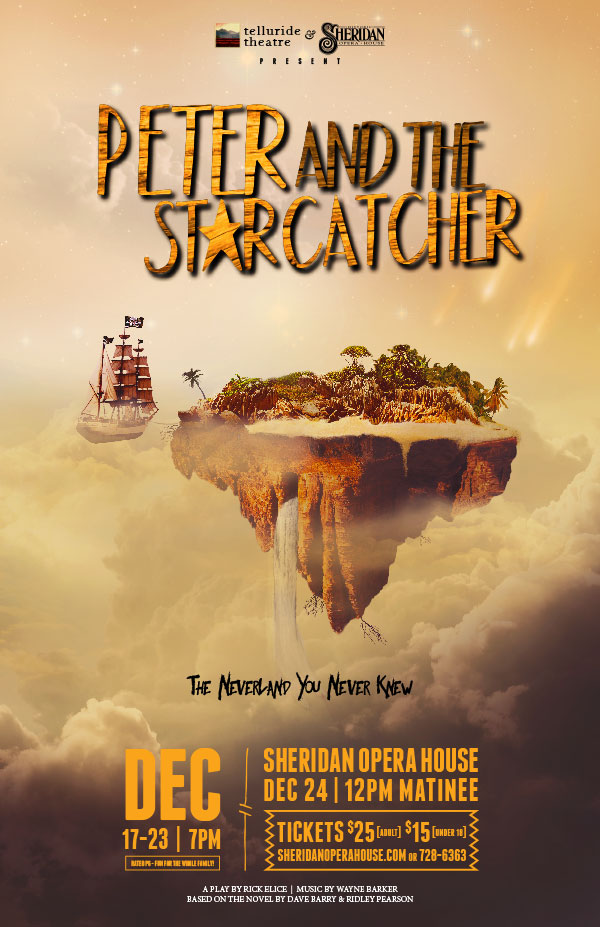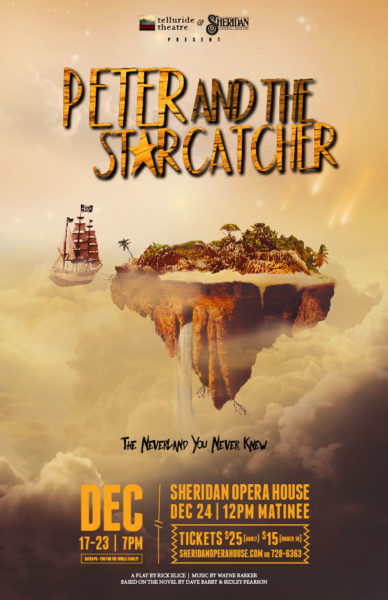
18 Dec “Peter & The Starcatcher: I Gotta Crow
Telluride Theatre and the Sheridan Arts Foundation present “Peter & the Starcatcher.” Evening performances at the Sheridan Opera House through Friday, December 23, 7 p.m. Saturday, December 24, is a noon matinee. Tickets are $25 for adults; $15 for kids 18 and under. To purchase tickets go here or call 970-728-6363 ext. 5.

“Er-er-er-errrr…”
I gotta crow.
And you will too, everyone will, after seeing director Sasha Sullivan’s campy, comic, creative adaptation of Rick Elice’s “Peter & the Starcatcher.” The gravity-defying production is a guaranteed Scrooge-buster, the biggest, best-est Christmas present you could ever give to family and friends this holiday season. And it comes beautifully gift-wrapped in the jewel box known as the Sheridan Opera House.
In short, “Starcatcher” is the theatrical equivalent of joy to the world. It is a hold-onto-your-hat kind of wild and wooly ride that demands your full attention. Promise, if you look away for an instant, if you blink, you will miss the purposely hyperbolic explanations of the various Neverland elements and all the crackling wordplay, puns, double entendres, witticisms such as “cleaner than the sheets at a convent” and “you made your bed, Pan.” Your heart will fly with this show, at once as comfy cozy and as scary as most bedtime fairytales.
The prologue to Act II, a blissful chorus of singing mermaids in drag, alone is worth the price of admission. We asked the three-year-old angel next to us after the show: “What was your very most favorite part?” Without hesitation: “The mermaids!”
It all started in 2002, when best-selling thriller writer Ridley Pearson was reading J.M. Barrie’s “Peter Pan” to his then five-year-old daughter Paige. The little girl reputedly asked a simple question: “Where did Peter come from?” How did he meet Captain Hook and Wendy Darling?
From that question came the best-selling novel by Pearson and comedy writer David Barry.
From that novel came Elice’s play, which radically reimagined Pearson and Barry’s words, turning the more or less straightforward, action-filled narrative into a fantastic, rib-slappingly funny yet poignant, eyes-wide-open adventure in which 13 (in the local show) hyperactive, uber-talented actors play many roles – as well as standing in for scenery and props, yes really – to provide the backstory about how a nameless, angsty orphan became the immortal Peter Pan.
Elice tells his version of the tale as both straight adventure and absurd farce, parodying the narrative and theatrical conventions of the many and frequent stage interpretations surrounding the mythology of Peter Pan. In the end, his production was meant to be intimate and accessible; Elice’s vision less “Finding Neverland,” less Big Broadway Show, more homespun, more “Our Town,” so perfect for the Opera House stage.
In both book and play we learn how it is Peter can fly, how he finds Wendy, the origins of Tinkerbell and Captain Hook’s hook, and the ticking crocodile – life before Neverland (or Pandom).
Set in 1885, the narrative is based on an elaborate voyage to a remote island, h0me to a sadistic ruler who delights in feeding lost boys to his pet snakes. The point of the journey is for a scientist named Lord Aster (David MacMillan, convincing as high born, clever, loyal, pragmatic, but still loving) to dispose of a mysterious treasure on the order of Queen Victoria and thus save the world. Lord Aster is also a Starcatcher.
Among the passengers on this treacherous trip are Lord Aster’s daughter, Molly, Allie Couture* (Scherich), who could well be playing a younger version of herself. Molly/Allie is the future mother of Wendy, radiantly beautiful, whip-smart, self-confident, spunky, athletic, determined, contagiously optimistic, charming with just of note of unease and self-doubt appropriate in a 13-year-old, albeit precocious, teen.
Molly is the show’s North Star: it is she who makes the decisions and takes the actions that save the day – or at least postpone further conflict in the alternate universe of Pandom. The limelight loves Molly/Allie. You will too.
And it is Molly who rescues the Boy Who Would Become Peter. Petra from which the name Peter is derived is Greek for rock, as is Saint Peter, rock of the church – and ultimately rock star or shorthand, locally anyway, for Colin Sullivan, also executive director of Telluride Theater (and director Sasha husband).
On opening night, we finally got to see what the generally upbeat Colin looks like when he is not happy. When we first meet Boy/Colin, he appears all gray, as if clothed in clouds (to hide his light?).
Boy has been orphaned so long he has forgotten his name. He is snarling, sullen, and very very mistrustful of grown-ups – for good reason. Adults have screwed him. But with the help of Molly, Boy is transformed into the joyous, reckless, exuberant, anarchistic, mischievous, resourceful, strong, eternal child he has always dreamed of being – though one who remains wary of grown-ups.
This is Colin at his best: his performance is textured and understated, while getting all the salient points across perfectly. Per usual, Boy/Colin managed to grab the crowd by its arm and never let go. (And we didn’t want him to.)
It seemed like kismet, i.e. inevitable, that Nathan Scherich* would wind up playing the pirate captain Black Stache (later Captain Hook). Why? Because Elice (again, the play’s author) also adapted “Jersey Boys,” the Broadway mega hit which was Nathan’s day job for years.
If you missed Nathan back in 2001 when he dominated the Opera House stage as Frank N. Furter in the cult classic “The Rocky Horror Show,” don’t miss him doing his worst as the narcissistic pirate captain Black Stache ( so named because of his Groucho Marx/Gomez Addams prosthetic facial hair).

Black Stache (Scherich) and Smee (Burgess)
Nathan as Black Stache was flamboyant, physical, loud and in your face. Like Allie and Colin, Nathan owned the stage – ok, so he shared it – when he was on, flailing around or cajoling, making really bad puns, but always the very model of villainy – and a man who longs for an arch-nemesis to complete his tawdry little life.
And, as standard tropes suggest, he finds his counterpoint in Peter– though there is a strong argument to be made that Hook is really Peter’s shadow side, not a whole other person. Could the two characters in fact be two sides of the same coin? Was that Barrie’s subtext? Boy/Peter, like Stache/Hook, has a huge ego and can be impossible to reason with. Both men are impulsive; both difficult – though in most interpretations of the tale, Peter ultimately chooses the light; Hook the dark.
The entire supporting cast is outstanding too, such as Sam Burgess’s antic, well-articulated Smee, Black Stache’s Man Friday. Peter Lundeen is such a drag, I mean, in drag, in this show in which he gives his best and certainly funniest performance ever as the stubbly nanny Mrs. Bumbrake and Teacher the Mermaid (transformed by stardust from an ordinary fish). As the blood-thirsty queen of a tribe of tropical islanders or Molluscs who speak Italian menu and dislike the English, Sue Knechtel as Fighting Prawn is pitch-perfect. As an actress, Sue has never pulled her punches and in this role, her over-the-top is as delicious as a plate of spaghetti bolognese.
Boy’s sidekicks, two other orphans, are the perpetually hungry (really for love and affection) Ted, played by Jaxon Mosher and Prentiss, the would-be leader (again for the attention he lacked growing up), Simon Perkovich. Both delivered fearlessly and without a safety net, as did Paul Jones as Alf, Mrs. Bumbrake’s besotted suitor; Evan MacMillan as Sanchez/Grempkin; and Shellane Steiger as Captain Robert Falcon Scott.
While no one in the aforementioned cast of Sasha’s adaptation of “Starcatcher” actually flies, thanks to everyone involved, the production soars to heights where a hawk could get a nosebleed.
It is flat-out amazing what Sasha & Co. – costume design, Melissa Trn; set design, Erika Bush; lighting design, Tommy Wince; props, Chanelle Hicks – managed to pull off with course material (except, of course, for Molly’s luminous garb), some strategically placed padding – check out Alf’s belly – ordinary rope (rippling to convey waves) a few household appliances and accessories (like rubber gloves that morph into Tinkerbell), banner flags (crocodile teeth), flashlights (croc eyes), two toy boats, clever lighting, and sound effects (including Alf’s nonstop, well, he has a lot of gas.)
Much of the entertainment value of the production springs from the constant movement on stage: choreographer Danielle Jenkins sorted out the dances; Sasha and Colin created the fight scenes. The collective effort helped to coax the manic action into something funny, yet believable (sort of, like the singing mermaid scene).
The music in “Starcatcher,” a very difficult score in a play with music, though not a traditional musical, is thanks to musicians extraordinaire Ethan Hale and Anna Robinson.
Telluride Theater’s “Peter & the Starcatcher” in mood and pacing alone – according to Colin, the Telluride production runs shorter than the Broadway original, which was done at breakneck speed – is Monty Pythonesque, filled with spoof, mirth, magic, and mock terror. As a linguistic banquet, the show is a basketful of fun – with interludes of tragic dislocation and abject fear.
Exactly like childhood.
But what is that elusive treasure known as stardust or Tinkerbell’s pixie dust, after all? What is this thing the Asters, both Starcatchers, are chasing? Aren’t we, after all, made of the same thing as stars? According to the play, stardust only transforms us into what we want to be if we believe.
‘Starcatcher” is a play about believing in ourselves, especially in our dreams.
If we do, like Peter, we could fly.
(Or, become a really cool mermaid like Teacher.)
- Couture and Scherich appear courtesy of Actors’ Equity Association.


Pingback:2016 Holiday Concert Series | Telluride Inside... and Out
Posted at 12:34h, 24 December[…] “Peter & The S… 107 views […]